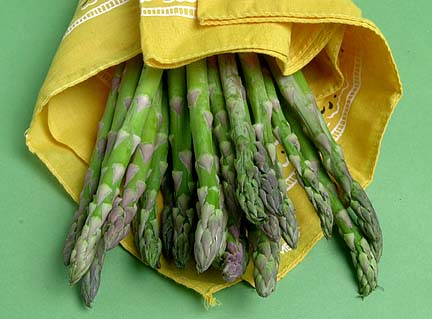

Key Ingredient

KEY INGREDIENT: ASPARAGUS
Asparagus traces its roots to the eastern Mediterranean some 2,000 years ago. It was originally cultivated for its medicinal properties. Asparagus plants have a lifespan of 10 to 20 years. The size of the asparagus spear reflects the age of the plant, with older plants bearing thicker spears.
Asparagus is a good source of folic acid and also contains vitamins A and C, potassium, vitamin B6, and iron.
The basics: There are more than 300 varieties of asparagus, of which only about 20 are edible. Green asparagus is the type commonly sold in the United States. Many Europeans are partial to white asparagus, which is grown underground to prevent it from turning green. There's even a variety of purple asparagus, which has a fruitier flavor than its green cousin. Asparagus is available fresh, frozen and canned.
Selecting: Look for crisp, firm stalks with tightly closed tips and bright green color. Avoid asparagus with heads that have begun to flower. Generally, thinner spears are the most tender. Choose spears of similar size to ensure even cooking.
Storing: Fresh asparagus may be refrigerated for 3 or 4 days. Wrap in a damp cloth and store in a plastic bag. Alternately, place the spears upright in a pitcher containing a few inches of water, and cover with a plastic bag.
Use: Wash thoroughly, to make sure the tips do not contain any soil or other impurity. Hold each spear with two hands toward the base of the stalk and bend the spear. It should break at the place where the stalk begins to toughen. Discard the bottom ends or retain them for making soup. If the remaining stalks still appear a bit fibrous, they may be peeled with a vegetable parer (thinner stalks generally do not need paring).
Asparagus is a highly versatile vegetable and may be steamed, boiled, sauteed, stir-fried, microwaved, roasted or grilled. Avoid overcooking asparagus, or it will become mushy and lose its flavor, color and nutrients.
Fresh asparagus generally needs no seasoning except for a dash of salt and pepper. Still, melted butter, Hollandaise or black-bean sauce, mayonnaise, chopped hard-boiled eggs, buttered bread crumbs and grated Parmesan cheese are excellent toppings for this vegetable. Serve asparagus hot or cold.
Where to buy: Fresh asparagus is available in most supermarkets. The optimum season for domestic asparagus is February to June, when the prices fall to about $2 to $3 per pound.
Food Stuffs: Morsels
Barbara Burke is a Hawaii-Pacific University instructor who teaches and writes about food and nutrition. Contact her at the Honolulu Star-Bulletin, 7 Waterfront Plaza, Suite 210, Honolulu 96813; or e-mail her at: features@starbulletin.com